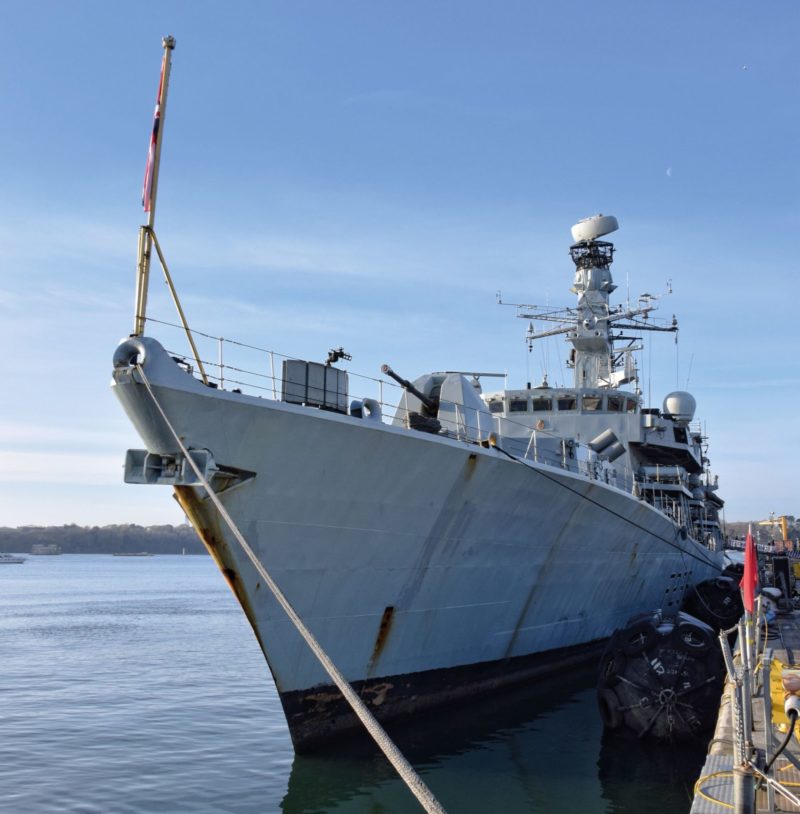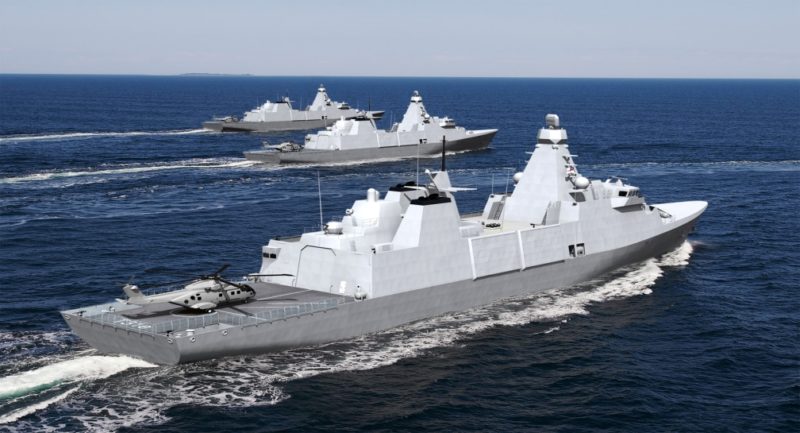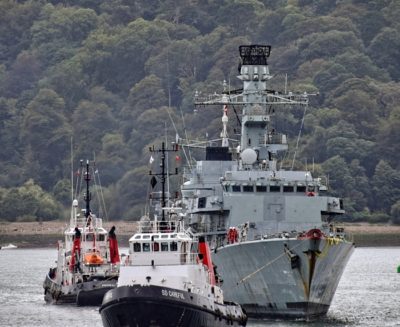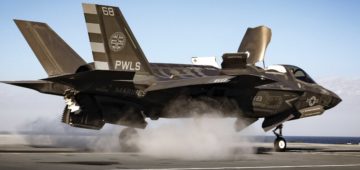
The decision to move from ‘sea days’ reporting to ‘readiness days’ for expressing how operationally ready the Royal Navy is seemingly makes sense in an era of ‘platforms’ for sophisticated, cutting-edge tech, such as drones. ‘Readiness days’ means a warship or Royal Fleet Auxiliary (RFA) vessel being available and delivering an operational impact whether at sea or in port. This sounds a lot like having a ‘fleet in being’ instead of an active force exerting a presence on the oceans. Two decades ago the RN trumpeted the concept of ‘swing’ (the ability for a ship to be out doing a task other-than-war in one part of the world and then, when called on, being swiftly on task ready for combat).
The US Navy is currently showing how that works, with three destroyers in the Red Sea busy shooting down multiple drones and, if needs be, even missiles that pose a danger to themselves and merchant shipping. It is not a mission that, when they deployed some weeks ago, their crews could ever have imagined performing. But a war between Israel and Hamas in mid-October called on USS Carney to intervene in shooting down Land- Attack Cruise Missiles (LACM) fired by the Iranian-armed Houthis in Yemen. They were heading for an Israeli tourist resort, while Houthi drones were also blasted out of the sky by the Carney. A few weeks later USS Thomas Hudner was opening fire to destroy drones that posed a direct threat to her. Late last month (Nov) sister vessel USS Mason intervened in an attempted hijacking of a merchant ship only to have a ballistic missile fired in her direction by the Houthis. Fortunately the missile missed both the Mason and the merchant vessel by a wide margin. The same Arleigh Burke Class warship in 2017 was actually forced to use her own missiles to neutralise an incoming Houthi missile. The most recent episodes, involving the Arleigh Burke trio, were an exemplary illustration of a navy exerting presence while having the numbers of well-armed ships to provide a swift and decisive response. In doing so they provided immediate protection for themselves and the sea trade upon which we all rely. At the same time as the Houthis were firing a missile with reckless abandon into shipping lanes, in Russia – currently waging a major war against Ukraine and with vastly more sophisticated capabilities – a Kremlin spokesman suggested further European Union (EU) sanctions imposed on his nation could result in a sea ‘blockade.’ Whether or not he meant by naval forces – or was actually suggesting a retaliatory embargo – was unclear. But, the most likely fashion in which Russia would seek to disrupt the EU’s maritime business would be covertly, following on from its suspected cutting of seabed pipelines and communications cables in the Baltic. Possibly it could secretly set mines adrift in the waters of EU nations, challenging the latter’s mine warfare vessels to maintain a constant vigil.
As most European nations are members of NATO, the Alliance’s two standing forces of Mine Counter-measure Vessels (MCMVs) – which are very busy – could be pushed very hard to take the edge off major disruption to trade and sea transport. The UK, while not a member of the EU, could expect to have its ever-shrinking MCM forces suddenly much in demand at sea. A mine threat in European waters is surely not something anyone could have imagined becoming a reality pre-2022.
The same is true of the seabed infrastructure sabotage, not yet confirmed to be the Russians but more than likely to have been them. The UK has introduced into service a new vessel to counter seabed sabotage, though it is not yet operational.
Another geopolitically unpredictable part of the world where Royal Navy warships are certainly prominent on the high seas is Indo-Pacific. This is via two River Class (Batch 2) patrol vessels which are doing great things via tasks-other-than-war. However, should things turn nasty between the West and Beijing in the South China Sea, or around Taiwan, they will be of no use in high-end warfare other than as hosts for counter-mine teams. When replaced by Type 31 frigates in the late 2020s that situation will change, as those vessels are bigger and better armed. But a lot could happen in the next six years that may expose the risks taken in sending lightly armed patrol ships into a region of high-end threats.

There will at least be a highly-capable RN ship putting in sea days out in Indo-Pacific in 2025, namely the aircraft carrier HMS Prince of Wales, leading a UK Carrier Strike Group (UKCSG) that will likely include US and European naval vessels. The carrier herself will possibly embark both UK and US Marine Corps F-35B jets and MV-22 tilt-rotor aircraft alongside RN helicopters, and even USMC infantry alongside Royal Marines. But, it will be four years since the last time the UK fleet deployed a CSG to Indo-Pacific, putting in serious numbers of sea days, from home waters to the Mediterranean, Indian Ocean and Pacific and back. There is not much deterrent value offered to reassure regional allies by such infrequent deployments.
The British do overall squeeze a lot of sea days out of a declining number of frigates, destroyers and patrol vessels in European waters. But, due to defects, refit delays – and a lack of people to send more vessels to sea – the burden falls on a small number of ships and people, which is very hard on them. So, ‘sea days’ is going out of fashion in the UK because it is hard to achieve more with such a small, relatively under-resourced operational navy, facing a recruiting crisis and challenges in retaining sailors it has spent years training at great expense. For all the fancy advertising campaigns that look at other motivations for joining the RN, the primary driver has to be an active working life at sea – doing the very valuable job of protecting the UK and its allies – while also being well paid and with training periods, leave plus with the chance of some shore jobs back home to create a stable family life. But something in the mix is not right when it comes to recruiting and retaining enough people. If not tackled now it will hobble the future RN when its new ships start to join the fleet.
AS explained by the First Sea Lord during testimony to the House of Commons Defence Committee last month (see P12/13) decisions are being taken to reduce the strain on vessels and their people, by keeping them in port as much as possible. They are sent out when needed to work with NATO allies, or meet a specific planned commitment or new threat (the latter when acting on intelligence). But, what if the intelligence is faulty, and how does a Navy that is not out there detect the unsuspected nefarious activities of likely foes and, if needs be, take decisive immediate action to eliminate them if its vessels are in port or trapped in a major refit? Or even worse cannot get into a dry dock for major work that is needed to return them to the active fleet (as is the case with the attack submarine HMS Audacious, which has been alongside awaiting work at Devonport since April 2023). A particular issue of concern this year when it comes to British naval readiness was that on one day in 2023 there were no attack submarines (SSNs) at sea. When asked why this happened by the Defence Committee, the First Sea Lord gave a reasonable response – their services were not needed that day. During another evidence session Deputy Chief of Defence Staff, Lieutenant General Rob Magowan, a Royal Marine, explained to MPs why no submarines had been at sea that day. “If it were easy, then we would have all the submarines to sea,” he said, “but they are not designed for all to be at sea anyway. But there is an overall programme, because you are absolutely right that it is an operational weakness.” That weakness is too few available submarines, with it taking more than 20 years to build just seven Astute Class SSNs. Extant submarine readiness levels are also below par after being hit by the need for an overhaul of support infrastructure, supply chain management and skilled manpower shortages, particularly of engineers. This needs to be sorted out, for SSNs are a major conventional deterrent tool that is also integral to the operational safety of Trident nuclear missile submarines. Admiral Key was more upbeat on the future direction of readiness levels. However, the new ships are still years away from being able to have a significant impact on readiness. Overall the fleet is too small, and there is little slack left to mitigate problems that impact on readiness. If the destroyer and frigate forces falls to just eleven, as elderly Type 23s are decommissioned early that means there may be only five or six such vessels available at any one time for global operations.


It will put even more strain on them and their people (even if ships are run on the two-crew system). Skilled manpower cut over a decade ago will take years yet to replace. New infrastructure to support submarine operations will take years to put in place even with the recent multi-decade contract signed with Babcock for infrastructure upgrade work at Devonport in Plymouth. And yet, surely, the urgent need for such projects was not unforeseen? The decisions that matter have come too late to avoid harming the navy’s operational effectiveness. The situation can be spun whichever way the UK Ministry of Defence wishes, but the chickens of 30 years neglect and mismanagement of Defence by governments are coming home to roost. The navy could undoubtedly put up a good fight on the day of the match but what about the next day and the one after that?
The Ukraine War shows that people who assume wars will last a matter of days or weeks can be caught out and blitzkriegs turn into years-long wars of attrition. Numbers matter, as does firepower and the ability to keep feeding the beast of war.
As Admiral Key pointed out, the UK will be fighting alongside allies if war comes, but there is only so much the small navies of Europe can do.
Also, national priorities – a willingness to take risks – even within NATO, may not align while there is only so much heavy lifting the US Navy can handle.
It faces a myriad of major threats to global security, not least from China.
MEANWHILE, the Royal Navy is doing the best it can to play a rotten hand, which it has been dealt by successive governments since the early 2000s. They have cut the fleet, failed to provide resources needed to fully maintain what is left and presided over a precipitous decline in recruitment.
There is a growing sense that rather than fix the problems and take action the current government is – in the face of economic difficulties caused by Brexit, the pandemic and war in Ukraine – doing all it can to avoid substantive and decisive extra investment in the UK Armed Forces commensurate with meeting the current and looming threats at (and from) the sea. One day that neglect could well cost lives and inflict serious damage on the UK and its allies.
Discarding ‘sea days’ seems only the latest ploy to hide political embarrassment at the cupboard almost being bare of ships and people to deploy – and yes, it is all the politicians’ fault. Blair, Brown, Cameron, Clegg, May, Johnson and Sunak, are the guilty Prime Ministers who fiddled with naval defence while burning issues were ignored.
For the Royal Navy itself, abandoning ‘sea days’ is a slippery slope.

If the capability and readiness managers start disconnecting the RN from ships/submarines/the fighting fleet at sea then they risk destroying the essence of what the Navy is about, along with its ethos. Without the ships doing their business in great waters and making port visits the RN becomes even more of an enigma (and a daily irrelevance) to both allies and the UK taxpayers who pay the bills. The Royal Navy is its people and its warships, with the White Ensign flying over the oceans, or it is nothing.





Comments
Sorry, comments are closed for this item